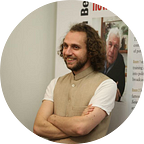Clarity for Teachers: Day 1
‘Until you know how to be clear, rely on those who do.’
I remember being young, let’s say twenty, and the growing suspicion that life did not have to be the muddle I mostly experienced it as.
It wasn’t just something that happened to us all, it was something we had some influence over, and there were people who showed signs of skill at exercising this influence over their lives and their surroundings. There were, you might say, people who knew how to be clear — or, at least, knew more than I did about it.
As this suspicion grew and I learned to trust it, what a relief it was! A fog had begun to lift, revealing a new landscape of possibility.
It’s a big lesson, for some of us: learning to trust that there are others who have more skill than me, not just at the obvious practical and intellectual skills they talked about in school, but in this domain of subtle skill which our culture barely seems to have the words for.
It’s also an aspect of a bigger lesson: learning to recognise the entangled differentiation between the world and my experience of the world. It’s nothing as neat as drawing a line between what’s ‘objective’ and what’s ‘subjective’; it’s more like developing a feel for the material, the way a woodworker or a carpenter will do, a respect for the ways it responds to or resists her touch. The material of my experience is neither just how things are, nor just how I want things to be, but an endless interplay that I have to learn to notice. (I don’t have to anything, of course, but the interplay gets interesting as I start to give attention to it.)
Looking for those who know more than I do about how to be clear — perhaps we could think of this as a matter of apprenticeship? An apprenticeship in the craft of working with the material of human experience.
There is one more lesson here that comes to mind. If it helps to realise, as I did at twenty, that there are people who know more than me about how to be clear — that my muddled experience of life is not all there is or could be — then there’s an opposite trap, an extension of this line of thinking that becomes unhelpful. This is when I start to think that there’s another kind of person: one who has it all together, one whose life is free of mess and muddle, incompleteness and contradiction.
And maybe there is — but the best teachers I’ve had have always been the ones who are willing to own their unfinishedness, to share the places where their knowledge runs out, while giving generously from the places where they have found their knowledge to be reliable.
As my friend Chris says, ‘Unless you can show me your incompleteness and contradiction, then how can I trust you?’ Because I know it’s there, and if you’re keeping that from me, what else might you be keeping?
Västerås, 4 March, 2019
I’m taking part in Clarity for Teachers, a course led by Charlie Davies. In the first part of the course, we are working through ‘A teacher’s advice on how to be clear’, which is Charlie’s version of the Buddhist text ‘Advice from Atisha’s heart’. So this is me writing a commentary on Charlie’s teaching of his reworking of Atisha’s summary of his own teaching, but frankly I suspect it’s Midrash all the way down.
Check out Charlie’s work on How To Be Clear. He promises to publish ‘A teacher’s advice on how to be clear’ soon as a set of cards.
